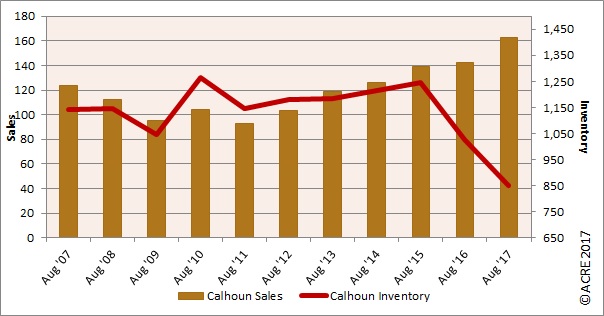By: ACRE Research
The Lake Martin waterfront median home sales price during February was $520,000, an increase of 48.6 percent from one year ago.
Click here to view or print the entire monthly report compliments of the ACRE Corporate Cabinet.
Sales: Lake Martin waterfront sales totaled 15 units during February, representing a 25 percent decrease from one year ago, when 20 waterfront units were sold. The 10-year peak for February waterfront sales was in 2017, when 20 units were sold, while the trough hit in 2010, with four units sold.
Forecast: February results were one unit or 6.3 percent below the Alabama Center for Real Estate’s monthly forecast. ACRE projected a total of 30 waterfront sales through February, while there were 28 actual sales.
Supply: The Lake Martin waterfront housing inventory in February was 206 listings, an increase of 17.7 percent from the previous month and a decrease of 16.9 percent from one year ago. This is consistent with historical data from 2013-17 indicating that February inventory on average increases from January by 16 percent.
Pricing: The Lake Martin waterfront median sales price during February was $520,000, an increase of 25.3 percent from the previous month and an increase of 48.6 percent from one year ago. Pricing will fluctuate from month to month because of changing composition of actual sales (lakefront vs. non-lakefront) and the sample size of data (closed transactions) being subject to seasonal buying patterns. ACRE recommends contacting a local real estate professional for additional market pricing information.
Demand: February waterfront sales increased 15.4 percent from the previous month. This is consistent with historical data indicating that February sales on average (’13-’17) increase from January by 19.6 percent. Waterfront homes selling in February averaged 189 days on the market, representing a 48.8 percent increase from one year ago. Waterfront homes on Lake Martin are currently selling 15 percent faster than the five-year average of 223 days on the market.
Seeking balance: There were 13.7 months of supply in February, up slightly from 13.5 months of supply last month and up from 12.4 months of supply one year ago. Restated, at the February sales pace, it would take 13.7 months to absorb the current inventory for sale. The market equilibrium (balance between supply and demand on a non-seasonally adjusted basis) is approximately 6 months.
Industry perspective: The 10-year treasury is a crucial indicator of economic expansion. As of March 1, 2018, the 10-year treasury stood at 2.88 percent, a slight increase from last month’s rate of 2.86 percent. Mortgage rates also experienced a slight increase recently as the current rate on a 30-year fixed-rate mortgage is 4.57 percent, up from 4.38 percent one month ago. As the economy continues to strengthen, people will have more money in their pockets with the intent to spend. This increase in spending will most likely create higher stock prices and lower bond prices. With this increase of confidence in the market, mortgage interest rates can be expected to increase.
The National Association of Home Builders (NAHB) produces economic analyses of the home-building industry based on government data. The Housing Market Index (HMI) depicts market conditions for the sale of new homes. The HMI ranges from 0 to 100; a rate greater than 50 represents good sales conditions.
The HMI in the South has stayed relatively steady in the past few months with a score of 73. However, the HMI is lower in some regions of the United States, such as the Northeast, which has a rate of 56. The West has a higher HMI of 77, and a better market for good housing conditions.
The Federal Housing Finance Agency uses the House Price Index (HPI) to measure the average price changes in repeat sales or refinancing on the same properties. The FHFA’s national HPI was up 6.7 percent from the previous year compared to Alabama, which has increased from the previous year by 5.6 percent. The HPI rose in all 49 states except for Mississippi.
Compared to the national housing market conditions, Alabama’s real estate market has been showing improvement. Although total residential sales in Alabama decreased 2.3 percent from January 2017, the statewide median sales price increased 2.3 percent from January 2017. Statewide, homes in Alabama are selling much more quickly than in recent years as the average days on the market decreased 19.6 percent from one year ago.
The Lake Martin Waterfront Residential Monthly Report is developed in conjunction with the Lake Martin Area Association of Realtors to better serve area consumers.






